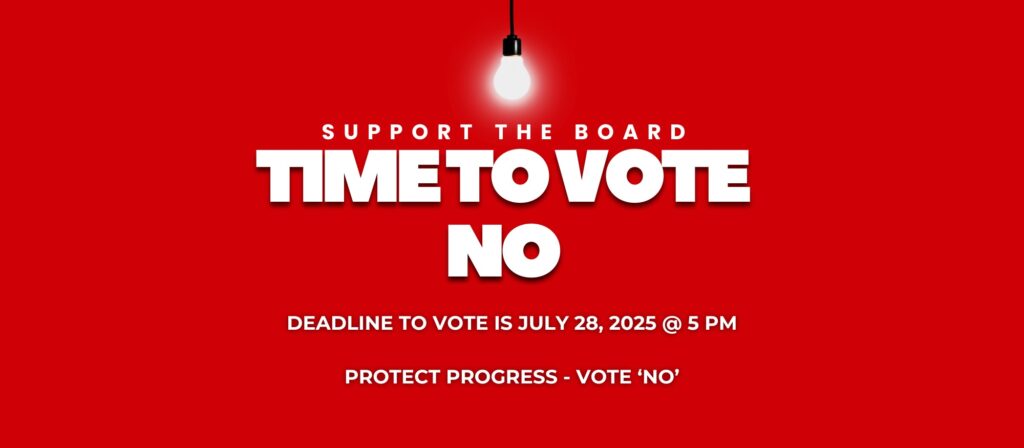
Let's not hand control of our community to a board that answers to CCMC and attorneys—VOTE 'NO' to Protect Homeowners' Rights and a board that advocates for Homeowners!
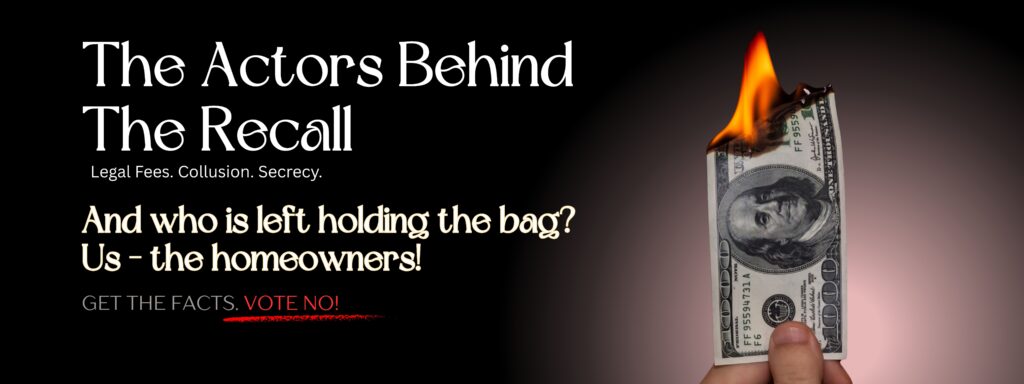
Legal Fees: Just The Facts
$20,219.80—By the End of May

By May 31, 2025, the HOA had already spent over $20,000 in legal fees. These charges weren’t for defending the community—they were tied to:
Communications with defendants in a defamation lawsuit
Drafting of recall removal ballots
Strategy planning with individuals leading the recall effort
What’s worse? This work began without the Board’s knowledge or consent, and long before the community was even notified of a recall!
📆 Detailed Billing Timeline: May–June 2025 for legal services rendered for individual current and past board members: Crystal Glaim, Mike Stone, Gordon Engstrom, Jennifer Rotta, Kristi Kisler
🗓️ May 13, 2025
Contact and Review of email from “Save Power Ranch” to law firm—the group aligned with the recall
💵 $105.00
Why it matters: Legal attention was already focused on the recall before the community or Board was informed it existed.
🗓️ May 27, 2025
Email with Michael Stone regarding TRO application; review of lawsuit and website
💵 $637.50
Why it matters: Michael Stone, a named defendant in the lawsuit, (filed on May 23, 2025) contacted the HOA attorney without Board approval. Legal work began on his behalf—billed to the HOA.
🗓️ May 29, 2025
Reviewed emails and texts with defendants; drafted strategy responses – $340.00
Finalized a letter to send to owners regarding lawsuit – $85.00
Reviewed email and video content from “Save Power Ranch” – $170.00
Email correspondence with Margaret Troyer re: defendants – $97.50
Reviewed legal procedure for motion to dismiss – $97.50
Drafted disclosure statement for lawsuit – $195.00
Saved legal communications to HOA network – $20.00
💵 Subtotal: $1,015.00
Why it matters: The law firm was actively working on statements, defenses, and legal positioning on behalf of individual defendants—again, before Board approval.
🗓️ May 30, 2025
Call with HOA manager about lawsuit and service issues – $127.50
Finalized disclosure statement – $32.50
Corresponded with Margaret Troyer re: disclosures – $32.50
Researched lawsuit claims – $195.00
Updated disclosure and corresponded again with Troyer – $32.50
Evaluated potential success of motion to dismiss – $780.00
💵 Subtotal: $1,200.00
Why it matters: These are complex litigation efforts, all undertaken prior to any authorization or transparency. Several communications appear to reflect efforts to guide defendants’ legal defenses.
🗓️ June 2, 2025
Strategy discussions on subpoena and recall issues – $212.50
Reviewed lawsuit documents and TRO scheduling – $212.50
Reviewed town hall communications and Board authority – $255.00
Emails with Glaim and Troyer regarding lawsuit evidence – $129.00
Reviewed summons and arbitration docs for Glaim – $32.50
Reviewed recall flyers and prepared legal opinions – $114.00
💵 Subtotal: $955.50
Why it matters: Crystal Glaim, also a defendant, began receiving direct legal guidance from the HOA attorney, again without full Board knowledge at the time. The law firm was now actively building recall strategy infrastructure.
🗓️ June 3, 2025
Prepared and drafted recall ballot and cover letter – $162.50
Reviewed recall statutes (A.R.S. 33-1813) – $65.00
Drafted Answer to lawsuit (Paragraphs 1–164) – $975.00
Reviewed and strategized on disclosure letters – $127.50
💵 Subtotal: $1,330.00
Why it matters: The law firm was now simultaneously preparing recall ballots and legal defenses for specific individuals—an entire month before the community or Board notified or authorized the work.
🗓️ June 4, 2025
Coordinated with former counsel; reviewed court documents – $520.00
Corresponded with Troyer and Glaim – $195.00
Drafted responses, researched sanctions, strategized disclosures – $487.50
💵 Subtotal: $1,202.50
Why it matters: Even as the Board remained unaware, the law firm was consulting with past attorneys, reviewing private content, and strategizing for the benefit of defendants.
🗓️ June 6, 2025
Reviewed background materials from Gordon Engstrom – $260.00
Drafted affirmative defenses; reviewed Board emails – $357.50
💵 Subtotal: $617.50
Why it matters: Gordon Engstrom, also named in the lawsuit, provided private materials that were reviewed—again, at HOA expense.
🗓️ June 10, 2025
Email correspondence with Glaim; reviewed alternative service motions; drafted rep agreement – $227.50
💵 Subtotal: $227.50
Why it matters: The law firm began drafting formal representation agreements for defendants with no Board approval, knowledge, or disclosure.
🗓️ June 11, 2025
Drafted email to Michael Stone; reviewed docket – $97.50
💵 Subtotal: $97.50
🗓️ June 12, 2025
Revised indemnity letters and representation drafts; emailed Stone – $195.00
💵 Subtotal: $195.00
June 13, 2025: The Board is finally called to meet and only to be pressured into signing a representation agreement for defense of Stone, Glaim, Rotta, and Engstrom—weeks after invoices had already accumulated, disclosures amongst the individuals, law firm and CCMC had been 'strategized' and signed. What's worse? According to court documents, current board members, Mike Stone and Jennifer Rotta were allowed to vote on representation while Anh was instructed to recuse herself.
July 2, 2025: The community is formally notified that a recall petition was submitted. By this point, the law firm had already drafted ballots, held legal strategy calls, and engaged with recall organizers, specifically Crystal Glaim—for over six weeks!
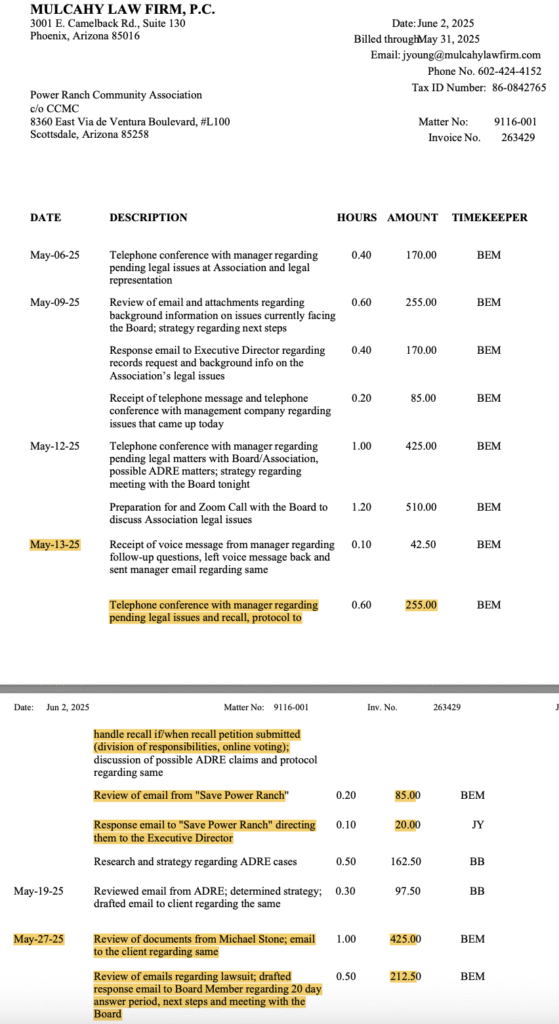

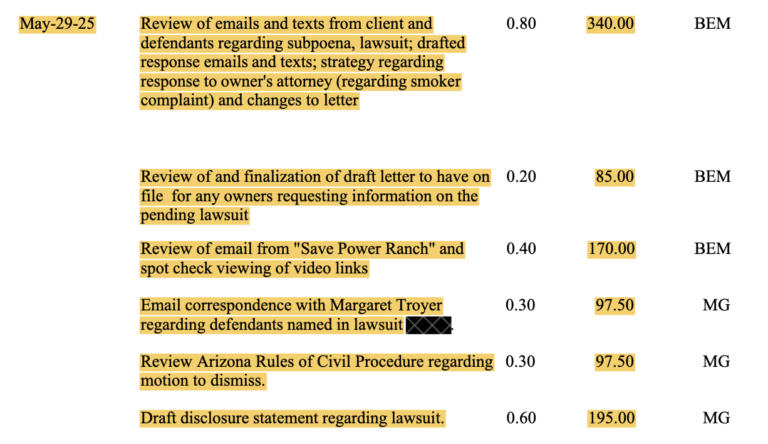


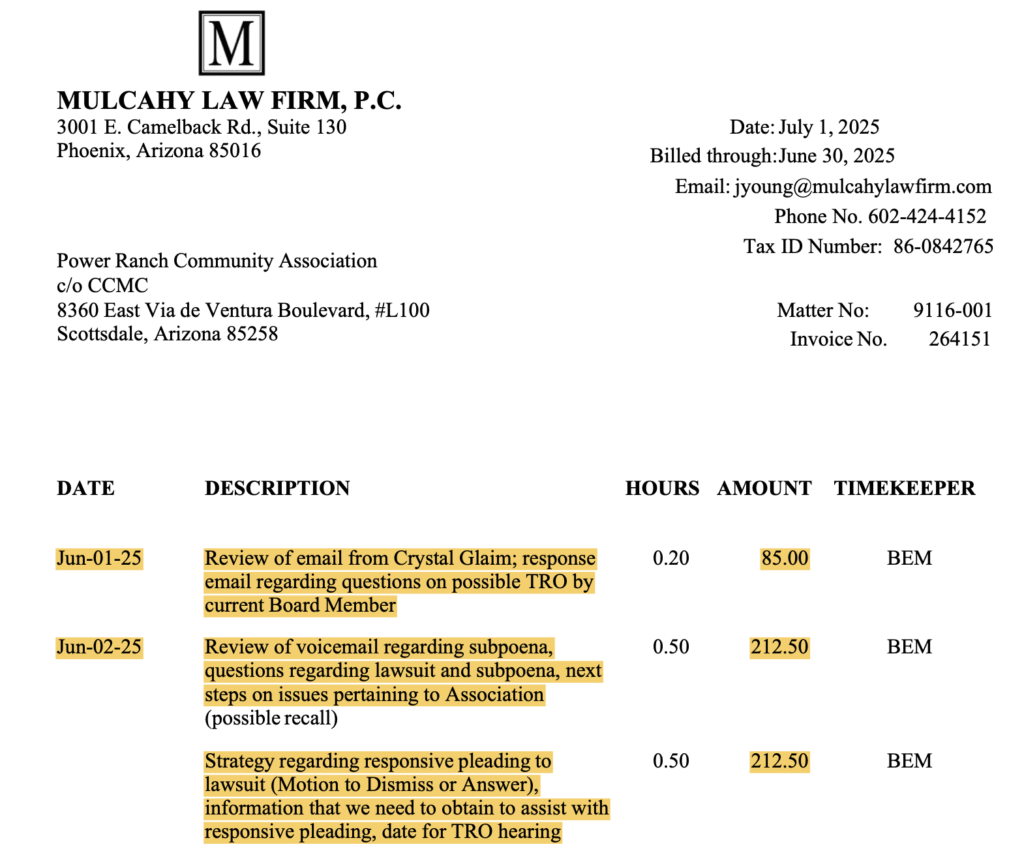

❗Why Every Homeowner Should Be Concerned
- These legal services were performed before Board approval, yet billed to all homeowners
- The HOA attorney was acting on behalf of individuals, not the Association
- There was no community disclosure while thousands of dollars were being spent
- The law firm failed to remain neutral and instead appeared to favor a select group
- This sets a dangerous precedent for misuse of HOA funds and politicized legal counsel
⚖️ Two Legal Opinions: The Association Should Not Be Involved
The Board sought legal guidance from two independent law firms.
Both firms reviewed the case and issued the same clear opinion:
The Association should not be involved in this private matter.
The HOA should not advance a legal defense for any of the named individuals.
Despite this, the HOA’s primary legal counsel continued performing services for defendants—and billed the Association anyway.
This directly contradicts expert legal guidance and undermines the very purpose of seeking outside opinions.
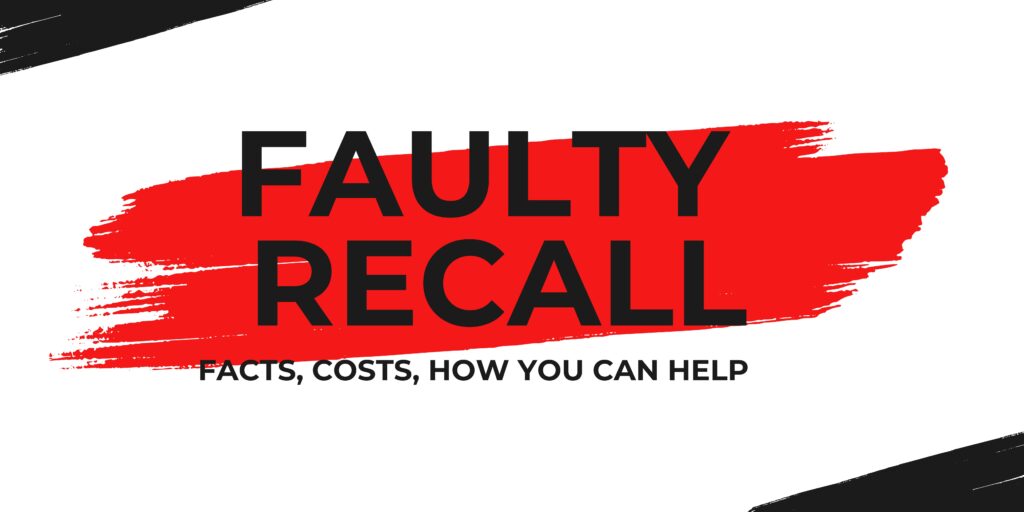
Understanding the Recall: Facts, Costs, and CCMC's role in it all - How You Can Help Protect Our Community
While every homeowner has a legal right to participate in our association’s governance — including the right to petition for a recall — it’s critical to separate fact from fiction.
Here is information so you can decide for yourself, understand what a recall is, what Arizona law actually says, the financial impact this process will have on all of us, and what you can do to support stability and transparency in our community.
What Is a Recall — And What Triggers It?
Based on A.R.S. § 33-1813(B) and assuming the association has 4,300 homes (and that each home holds one vote, which is typical unless otherwise specified in the governing documents), here’s how to calculate the required number of valid signatures to compel a recall special meeting:
🟨 Statutory Language from A.R.S. § 33-1813(B): “on receipt of a petition that calls for removal of a member of the board of directors and that is signed by the number of persons who are eligible to vote in the association at the time the person signs the petition equal to at least ten percent of the votes in the association or by the number of persons who are eligible to vote in the association at the time the person signs the petition equal to at least one thousand votes in the association, whichever is less…”
🔹 Statutory Requirement (Simplified):
The recall petition must be signed by a number of eligible voters equal to:
10% of the votes in the association
OR
1,000 eligible voters,
whichever is less
🔸 Application to Power Ranch with 4,300 Homes/Votes:
10% of 4,300 votes = 430 eligible signatures required
The alternate threshold is 1,000 signatures
✅ Since 430 is less than 1,000, the law requires only 430 valid signatures from eligible voters at the time of signing to compel a recall special meeting.
430 valid signatures must be collected from eligible voters to trigger a recall special meeting in an association with 4,300 votes.
🟥 CCMC’s Signature Verification Breakdown
According to CCMC, the following process was used to determine whether the recall petition met the required signature threshold:
Total Signatures Submitted: 560
Verified Owners: 454 (106 disqualified as fake or non-owners)
Disqualified for Delinquency: 3
Duplicate Signatures Removed: 33
Final Tally of Valid Signatures: 418
Rather than using 10% of the total 4,300 homes (which would equal 430 signatures), CCMC reduced the threshold to 387 by excluding households deemed ineligible due to delinquency.
📝 CCMC stated:
“The number of valid signatures required was 387.”
Their calculation appears to be based on a subset of currently eligible voters, not the total votes in the association (per ARS 33.1813B) — a distinction with serious legal implications.
❌ CCMC and Law Firm’s Logic:
Start with 4,300 total homes (assumed total votes)
Remove homes deemed ineligible due to delinquency
Reduce the denominator
Claim that 10% of the reduced pool equals 387, not 430
Validate the petition based on that lower number
✅ The Law’s Logic:
The 10% threshold is based on the entire voting power of the association (“votes in the association”), not 10% of currently eligible or non-delinquent voters.
Whether or not certain members are delinquent or ineligible to vote does not change the total number of votes in the association.
Nowhere in A.R.S. § 33-1813(B) does it authorize adjusting the 10% threshold based on delinquencies or active status.
The law says “10% of the votes in the association”, not “10% of eligible voting members at the time of the petition.”
🟩 Bottom Line
✅ Required number of valid signatures:
10% of 4,300 = 430 signatures
❌ CCMC’s threshold of 387 is invalid
They unlawfully reduced the denominator by removing delinquent households.
Therefore, 418 signatures does NOT meet the required signatures to call a special meeting. The recall election is invalid based on ARS 33.1813(B).
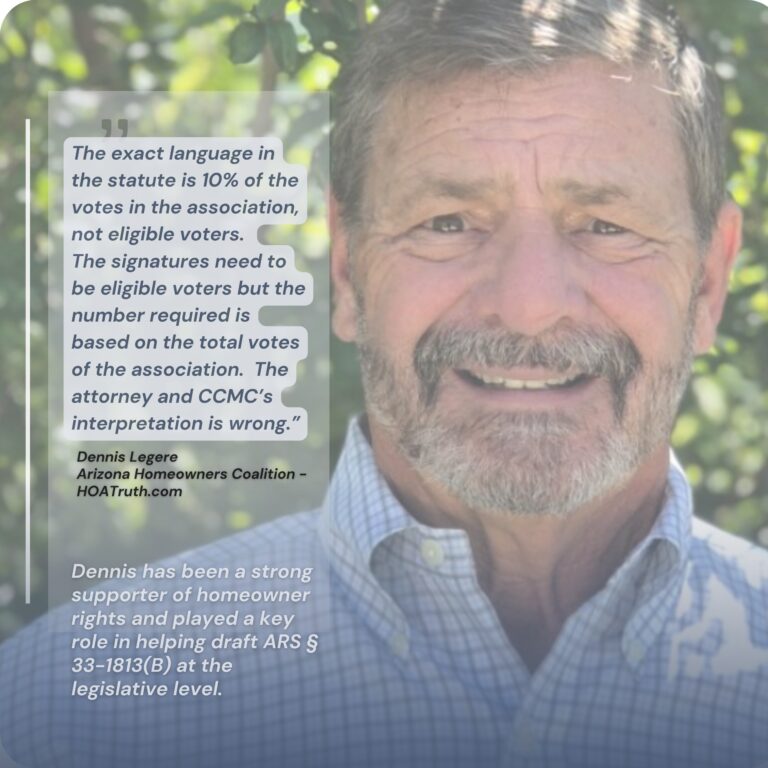
SHOW YOUR SUPPORT - VOTE 'NO'
BY DEADLINE JULY 28, 2025 @ 5 PM
PROVIDE YOUR FEEDBACK ON NEXT STEPS:
Stay Informed. Knowledge is Power.

Power Ranch HomeOwners Alliance
Unfiltered information provided for you by fellow owners. Need more information on a topic? Enter a keyword below and search our entire website:
Categories
- Appeals Process
- Arizona Legislation
- Board Meetings
- Board of Directors
- Carpenter Hazelwood Delgado Bolen, CHDB Law
- CC&R's, Bylaws, and AZ Revised Statutes
- CCMC
- Design Review Committee
- Fact Check
- Finance
- HOA Budgeting
- HOA Bullying
- HOA Open Meeting Law
- Landscaping
- Meeting Notes
- Power Ranch Homeowners
- Power Ranch Legal Counsel
- The Knolls
- Third Party Management
- Trade Organizations
- Uncategorized
